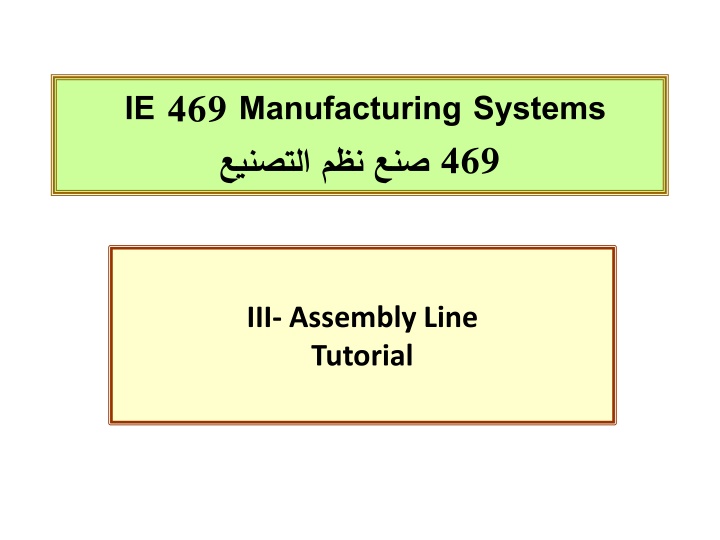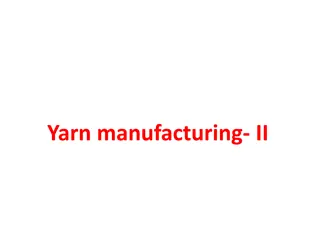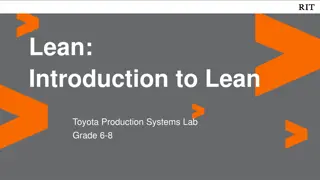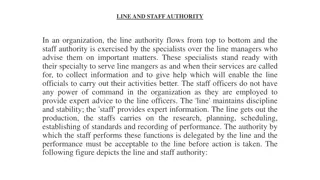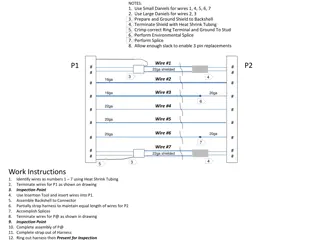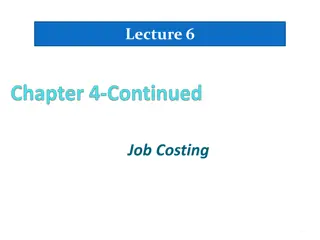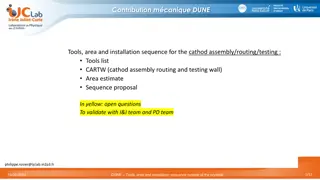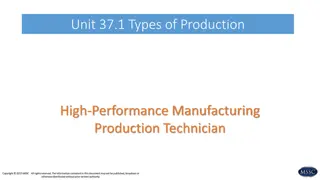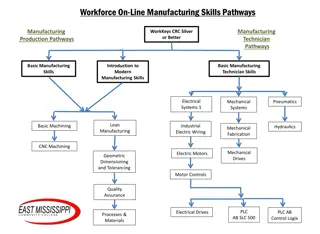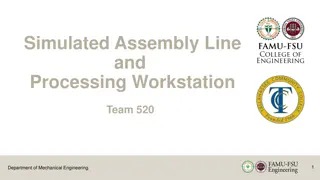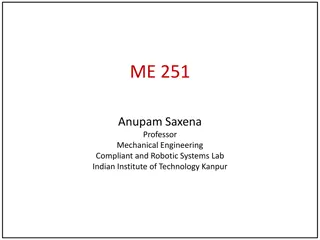Manufacturing Systems Assembly Line Tutorial
The tutorial covers problems and solutions related to automatic assembly machines, feed rates, cycle times, sensor levels, and operational proportions. It delves into scenarios like parts supply depletion, resupply time calculations, and the impact of feed rate adjustments on machine efficiency. Additionally, it addresses the minimum feeder rate required to keep up with a synchronous assembly machine's production pace during system uptime and breakdowns.
Uploaded on Sep 28, 2024 | 3 Views
Download Presentation

Please find below an Image/Link to download the presentation.
The content on the website is provided AS IS for your information and personal use only. It may not be sold, licensed, or shared on other websites without obtaining consent from the author.If you encounter any issues during the download, it is possible that the publisher has removed the file from their server.
You are allowed to download the files provided on this website for personal or commercial use, subject to the condition that they are used lawfully. All files are the property of their respective owners.
The content on the website is provided AS IS for your information and personal use only. It may not be sold, licensed, or shared on other websites without obtaining consent from the author.
E N D
Presentation Transcript
IE 469 Manufacturing Systems 469 III- Assembly Line Tutorial
Problem #1 Question 1 A feeder-selector device at one of the stations of an automatic assembly machine has a feed rate f=25 parts/min and provide a throughput of one par in four ( =0.25). The idea cycle time of the assembly machine is 10 seconds. The low level sensor on the feed rack is set at 10 parts, and the high level sensor is set at 20 parts. a) How long will take for the supply of parts to be depleted from higher level sensor to lower level sensor once the feeder selector device is turned off? b) How long will take for the parts to be resupply from low level sensor to higher level sensor once the feeder selector device is turned on? c) What proportion of the time that the assembly machine is operating will the feeder- selector devise be turned on? And Turned off? d) For the feed rate of the machine is f=32 parts/min, recalculate a,b,c. what is your comment?
Problem #1 Solution Solution when feed rate f=25 parts/min a) Time to deplete from nf2to nf1 rate of depletion = cycle rate Rc = 60/10 = 6 parts/min Time to deplate = (20-10)/6 =1.667 min b) Time to resupply from nf1to nf2 rate of resupply = f - Rc =25(0.25) - (60/10) = 0.25 parts/min Time to resupply = (20-10)/0.25 =40 min c) Total cycle of depletion and resupply = (40+1.667) = 41.667 min proportion of time feeder-selector is on = 40/41.667 = 0.96 proportion of time feeder-selector is off = 1.667/41.667 = 0.04
Problem #1 Solution Solution when feed rate f=32 parts/min a) Time to deplete from nf2to nf1 rate of depletion = cycle rate Rc = 60/10 = 6 parts/min Time to deplate = (20-10)/6 =1.667 min b) Time to resupply from nf1to nf2 rate of resupply = f - Rc =32(0.25) - (60/10) = 2 parts/min Time to resupply = (20-10)/2 =5 min c) Total cycle of depletion and resupply = (5+1.667) = 6.667 min proportion of time feeder-selector is on = 5/6.667 = 0.75 proportion of time feeder-selector is off = 1.667/6.667 = 0.25 Comment the turning rate of feed selector to the cycle rate of the assembly machine is important.
Problem #2 Question 2 A synchronous assembly machine has 8 stations at a rate 400 completed assemblies per hour. average downtime per is 2.5 minute. When a breakdown occurs all subsystems (including the feeder) stop. The frequency of breakdowns of the machine is once every 50 parts. one of the eight stations is an automatic assembly operation that uses a feeder- selector. The components fed into the selector can have any of five possible orientations, each with equal probability, but only one of which is correct for passage into the feed track to the assembly workload. Parts rejected by the selector are fed back into the hopper. What minimum rate must the feeder deliver components to the selector during system uptime in order to keep up with the assembly machine?
Problem #2 Solution Solution Tp= 60/400 = 0.15 min/assem. Tp =Tc +F*Td = Tc + (1/50)*2.5 =Tc +0.05 Tc= 0.15- 0.05 = 0.1 min/assem. Rc= (1/Tc) = (1/0.1) =10 assem/min Min f =0.2 f =Tc = 10 Feed rate f = (10/0.2) =50 parts/min.
Problem #3 Question 3 An automated assembly machines has four work stations. the first presents the base part, and the other 3 stations add parts to base. The production data are given Table below. Determine: a) proportion of good product to total product coming off the line b) production rate of good product coming off line c) total number defect of components and Number of assemblies containing defect component given the starting components quantities of 100,000 for each of part (Base, Bracket, Pin, retainer) which are used to stock the assembly line for operation d) total number of final assemblies produced Table (1) Station Operation / part Time, sec. defect rate, q jam rate of defect, m 1 2 3 4 Base Bracket Pin Retainer 12 10 9 10 0.01 0.02 0.03 0.04 1 1 1 0.5 Downtime= 3 min., When a component is jammed,and putting the machine back to work Indexing Time =3 sec., to move from station to station
Problem #3 Solution Solution Tc =12+3 = 15 sec 0.25min mq (1-q+mq) Tp=Tc+ mq*T d = 0.49min/cycle 0.01 1 0.02 1 0.98 a) Acceptable Ass. Yield= Pap= (1-q+mq) = 0.03 1 0.02 0.98 b) Production Rate, Rp = 60/Tp = 122.449 assemb./hour SUM 0.08 0.98 Production rate of good product Rap =Pap*Rp = Good ass./hr 120
Problem #3 Solution c) Number of defective components given a stock quantities Q=100000 are: Number of defect components for Base, Nd = Q*(1-q) = Number of defect components for Bracket, Nd = Q*(1-q) = Number of defect components for Pin, Nd = Q*(1-q) = Number of defect components for Retainer,Nd = Q*(1-q) = Hence the number of assemblies containing defect components are: Number of assemblies containing Base defect = Nd*(1-m)= Number of assemblies containing Bracket defect = Nd*(1-m)= Number of assemblies containing Pin defect = Nd*(1-m)= 1000 2000 3000 4000 def def def def 0 0 0 2000 Number of assemblies containing Retainer defect = Nd*(1-m)= 98000 Assemblies d) the total number of assembly produced=100,000*Pap= Number of good product = Total number produced - Number of parts produced containing defect part = 96000 Assemblies
Problem #4 Question 4 A six station dial indexing machine performs four assembly operations. The base is loaded manually at the station 1; the final product is unloaded at the station 6; and a component is attached to base at stations 2 to 5. The components are delivered by a hopper feeder to selector device for proper orientation. The system is designed with operating parameter given in the table below :- When a component is jammed, it takes an average 2 min to release and start the system. The mechanical and electrical assembly machine failure is not significant and can be neglected. It is found that the system produces assemblies far below the designed average production rate. Analyze the problem, stating any assumption to determine the following:- a) What is the designed average production rate? b) What is the proportion of assemblies coming off the system that contain one or more defective component? c) What seems to be the problems that limit the assembly system from achieving the expected production rate? d) What is the actual production rate? Station Assembly Time, Sec. 4 7 5 3 Feed Rate, f /min. Selector, defect rate, q jam rate of defect, m 1 0.6 1 0.7 1 2 3 4 32 20 20 15 0.25 0.5 0.2 1 0.01 0.005 0.02 0.01 Indexing time from station to station , Sec 2
Problem #4 Solution Solution Td = 2 min, Tc =7+2 = 9 sec. = 0.15 min Cycle rate, Rc = 1/0.15 = 6.667 cycle/min (a) (mq) = 1(0.01) + 0.6(0.005) + 1(0.02) + 0.6(0.01) = 0.04 Tp = Td + (mq) * Td = 0.15 + 0.04 * 2 = 0.23 min Rp = 60/Tp = 60/0.23 = 260.9 assemblies/hr (b) Pap = (1-q+mq) = (1 - 0.01 + 1 * 0.01) + (1 - 0.005 + 0.6 * 0.005) + (1 - 0.02 + 1 * 0.02) + (1 - 0.01 + 0.7* 0.01) = 1 * 0.998 * 1 * 0.997 = 0.995 Pqp = 1 - Rap = 0.005 Rap = Rp * Pap = 260.9 * 0.995 = 259.6 good assemblies/hr
Problem #4 Solution (c) Station 1: f = 32 (0.25) = 8 components/min Station 2: f = 20 (0.50) = 10 components/min Station 3: f = 20 (0.20) = 4 components/min Station 4: f = 15 (1.00) = 15 components/min the problem is that the feeder for station 3 is slower than machines cycle rate of 6.667 cycles/min. (d) if the machine operates at the cycle rate that is consistent with the feed rate of station 4, then: Tc = 15 sec = 0.25 min Tp = 0.25 + 0.04 * 2 = 0.33 min Rp = 60/0.33 = 181.8 assemblies/hr Rap = 181.8 * 0.995 = 180.9 good assemblies/hr
